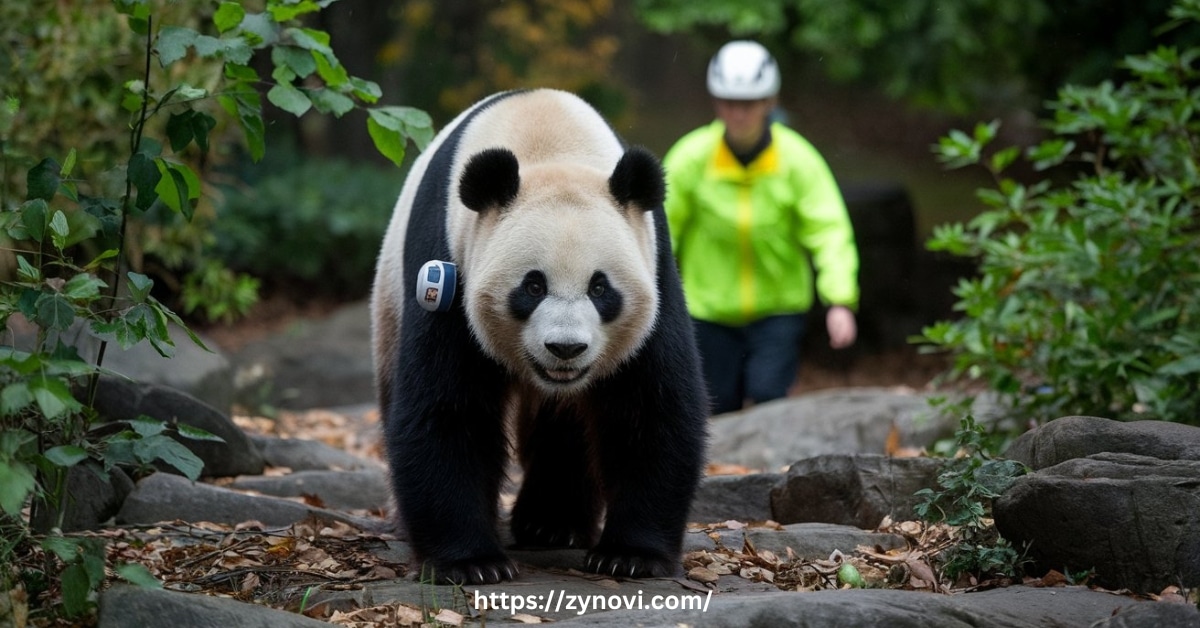Do Pandas Attack Humans? It might sound surprising, but these cuddly looking creatures aren’t as harmless as they seem. While pandas are often adored for their playful antics and docile appearance, they are still wild animals with sharp instincts.
If you’ve ever wondered whether these bamboo loving bears pose a real threat, you’re not alone understanding their behavior can reveal a lot about their true nature.
You might think of pandas as gentle giants, but the reality is more complex. From defending their territory in the wild to reacting to stress in captivity, pandas can exhibit aggression in unexpected situations. Ready to uncover the truth? Let’s find it!
Understanding Pandas: Behavior and Biology
What Are Pandas?
Giant pandas (Ailuropoda melanoleuca), members of the Ursidae family, are native to the mountain ranges of Central China, particularly in the Sichuan, Shaanxi, and Gansu Provinces. They are famous for their black and white coats, unique eye patches, and round faces. Pandas are primarily herbivorous, with bamboo making up 99% of their diet, although they occasionally eat small animals and carrion.
Key physical traits include:
| Characteristic | Detail |
|---|---|
| Weight | 200–300 pounds (90–135 kg) |
| Height | 2–3 feet (60–90 cm) |
| Bite Force | 1,300–1,500 PSI |
| Diet | Bamboo (primary), other vegetation |
Their pseudo-thumb allows them to grip bamboo effectively, while their powerful jaws and sharp teeth help them chew tough bamboo stalks.
Misconceptions About Pandas
The image of pandas as harmless, cuddly animals is largely shaped by conservation campaigns and media portrayal. In reality, pandas are wild animals with natural instincts, including territoriality and defensive aggression. While they are generally docile, provocation or perceived threats can trigger aggressive behavior.
Do Pandas Attack Humans? Separating Myth from Reality

Frequency of Panda Attacks
Panda attacks on humans are rare but not unheard of. Most incidents occur in captive environments, such as zoos or wildlife sanctuaries, where pandas are more likely to interact with people. In the wild, pandas’ solitary nature and remote habitats minimize the chances of human-panda interactions.
According to documented cases, attacks are often the result of:
Provocation: Attempting to touch or feed a panda can provoke aggression, as these animals are not accustomed to human interaction. Pandas, like most wild animals, may see such actions as a threat to their safety or territory, leading them to respond defensively.
Stress and confinement: Captive pandas may exhibit aggression due to the unfamiliar or stressful environments they are placed in. The lack of space, changes in routine, or the presence of unfamiliar people can all contribute to feelings of anxiety, causing the panda to act out of frustration or fear.
Maternal instincts: Female pandas can become highly protective of their cubs, showing increased aggression if they sense a threat to their young. These maternal instincts drive them to defend their offspring fiercely, even against perceived intruders, including humans who may be too close to the cubs.
Reasons Behind Panda Attacks
Pandas may attack humans due to:
- Threat perception: Pandas may feel cornered or threatened, especially when they have limited escape routes. In such situations, their natural response is to defend themselves, often resulting in aggressive behavior.
- Territorial behavior: They may defend their space, particularly in the wild, where they have established areas for feeding and resting.
- Food competition: Attempting to take food from a panda can provoke aggression, as they are highly protective of their resources. Pandas, especially in the wild, need to consume large amounts of bamboo daily, making food a critical part of their survival.
- Stress in captivity: Confinement and excessive human interaction can lead to erratic behavior, as pandas are solitary animals by nature. The stress of captivity, coupled with unnatural interactions, can cause them to feel agitated and more likely to lash out.
Documented Cases of Panda Attacks
Notable incidents include:
- Beijing Zoo (2006): A visitor climbed into a panda enclosure to hug a panda. The panda, startled, bit the individual, causing significant injuries.
- Tourist Incident: A tourist attempting to feed a panda in captivity was bitten on the hand, requiring medical attention.
While injuries are typically non-fatal, they can include deep bites and scratches due to pandas’ strength and sharp teeth.
Are Panda Attacks Dangerous?
Physical Strength of Pandas
Can a panda kill a human? Pandas are deceptively strong. Despite their docile nature, their bite force of 1,300–1,500 PSI is comparable to other large bears. This allows them to crush bamboo and could cause severe injuries to humans.
| Feature | Capability |
|---|---|
| Bite Force | 1,300–1,500 PSI |
| Claws | Sharp, capable of inflicting deep wounds |
| Physical Size | 200–300 pounds, strong muscular build |
Risks Associated With Attacks
While no fatal panda attacks have been recorded, injuries from their defensive behavior can still be severe.
These injuries may include deep lacerations from their powerful claws, crushing injuries caused by their strong bites, and infections that can result from untreated wounds.
Though pandas are generally not aggressive, their physical strength and natural instincts can pose risks when they feel threatened or cornered.
Staying Safe Around Pandas

Safety Tips for Encounters in the Wild
If you encounter a panda in the wild, it is vital to prioritize safety. Always maintain a safe distance of at least 20 feet to avoid any chance of confrontation.
Pandas may perceive quick or sudden movements as threats, so ensure your actions are slow and deliberate. Pay close attention to signs of stress, such as vocalizations, pacing, or erratic movements, which indicate the animal is uncomfortable.
If you need to leave the area, back away slowly and calmly; running can trigger a chase response, putting you at greater risk.
Guidelines for Captive Settings
In zoos or sanctuaries, it is essential to respect all safety protocols. Never attempt to bypass barriers or enclosures, as these measures are in place for both your safety and the animal’s well-being.
Refrain from feeding or trying to touch the pandas, as such actions can provoke stress or defensive behavior.
Always follow the instructions provided by zoo or sanctuary staff, who are trained to ensure safe interactions.
Responding to Panda Aggression
What to Do If a Panda Becomes Aggressive
Are pandas aggressive to humans? If a panda shows signs of aggression, it is crucial to remain calm. Avoid panicking or making loud noises, as this can escalate the situation.
Do not make direct eye contact, which may be interpreted as a challenge. Instead, slowly and carefully move away, giving the panda space to de-escalate.
Emergency Measures in Case of an Attack
If an attack occurs, protect vital areas such as the neck and face using your arms. Once you are safe, seek immediate medical attention for any injuries sustained and report the incident to the appropriate wildlife or zoo authorities for proper documentation and action.
Why Do People Misunderstand Panda Behavior?
Pandas are often seen as symbols of peace and innocence, a perception influenced by several factors:
- Cultural symbolism: Pandas are frequently associated with conservation and harmony, reinforcing their gentle image. In many cultures, particularly in China, the panda is viewed as a national treasure, representing calmness, balance, and friendship, which further enhances their serene reputation.
- Media portrayal: Viral videos tend to highlight playful or clumsy panda behavior, overshadowing their natural instincts and potential for aggression. These videos often focus on pandas engaging in amusing activities like rolling around or eating bamboo, which can mislead viewers into thinking that pandas are always docile or carefree.
- Behavioral differences: Captive pandas may appear more approachable due to their controlled environment, but wild pandas retain their territorial and defensive nature. In the wild, pandas are solitary animals and can become aggressive when they feel threatened or encounter intruders in their territory, highlighting the contrast in behavior between captive and wild populations.
Why Do People Misunderstand Panda Behavior?
Do pandas kill people? Pandas are often seen as symbols of peace and innocence, a perception influenced by several factors:
- Cultural symbolism: Pandas are frequently associated with conservation and harmony, reinforcing their gentle image.
- Media portrayal: Viral videos tend to highlight playful or clumsy panda behavior, overshadowing their natural instincts and potential for aggression.
- Behavioral differences: Captive pandas may appear more approachable due to their controlled environment, but wild pandas retain their territorial and defensive nature.
FAQs
Do wild pandas attack humans?
Wild pandas rarely attack humans due to their remote habitats and solitary nature. However, they may become aggressive if they feel threatened.
Are pandas dangerous in captivity?
Pandas in captivity can exhibit aggression, especially if provoked or stressed. Following safety guidelines minimizes risks.
What should you do if a panda shows aggression?
Stay calm, avoid sudden movements, and back away slowly to de-escalate the situation.
How strong is a panda’s bite?
With a bite force of 1,300–1,500 PSI, pandas have one of the strongest bites among mammals.
Have there been any fatal panda attacks?
No fatal panda attacks have been recorded. Most incidents result in injuries like bites and scratches.
Conclusion: The Reality of Panda Behavior
While giant pandas are undeniably fascinating and adorable, they are still wild animals with natural instincts that can lead to aggression under certain circumstances. Understanding their behavior, respecting their space, and adhering to safety measures are essential for harmonious human-panda interactions.
By appreciating pandas beyond their cuddly image, we can promote both awareness and conservation efforts for this endangered species.










